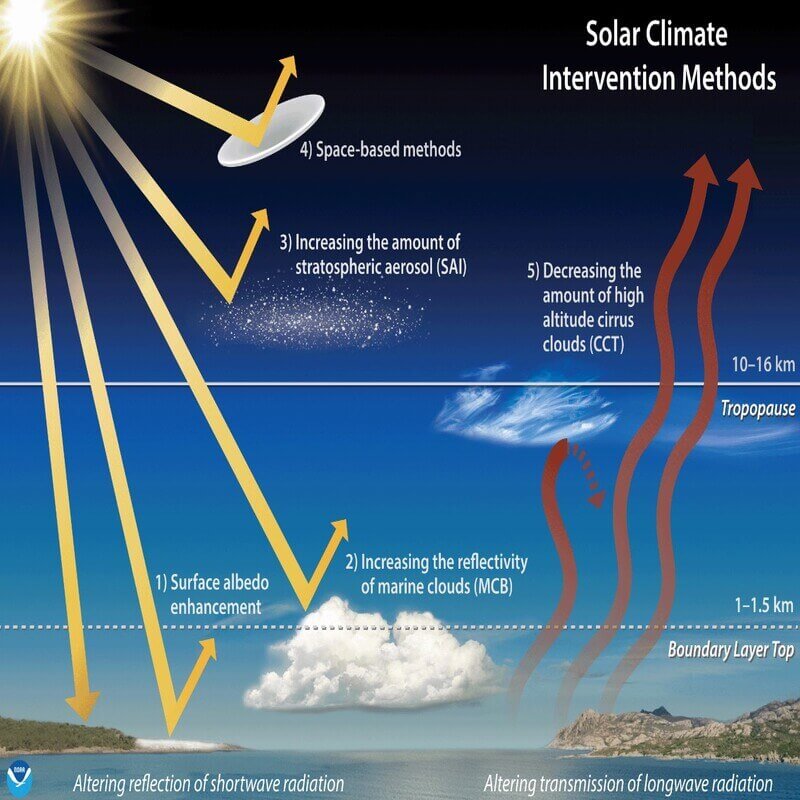
Solar Radiation Management involves a group of technologies that aim to cool the planet. It has been pitched as a potential way to counter the effects of global warming. How is the idea supposed to work? What is the status of research, potential risks, and impact of solar radiation modification (SRM)? Read here to understand.
Since the beginning of the industrial era, carbon dioxide (CO2) and other greenhouse gases (GHGs) have been accumulating in the atmosphere due to fossil fuel burning and changes in land use such as deforestation.
As a result, anthropogenic climate change is now affecting every region across the globe. The consequences of continued GHG emissions will be severe and long-lasting, including exceedance of temperature targets; increases in the frequency, intensity, and persistence of extreme weather and climate events; reductions in sea and land ice, snow cover, and permafrost; and sea level rise.
While international efforts must focus on rapid emissions mitigation and adapting to anthropogenically induced climate change, Solar Radiation Management (SRM) is being discussed as an additional approach to offset some impacts and avoid global temperature exceeding the limits set in the Paris Agreement, while the global energy system is being transformed.
Also read: Solar Energy: Potential of India
Solar Radiation Management (SRM)
The phrase “solar geoengineering” refers to a collection of speculative technologies that, in principle, might lower global temperatures by refracting more sunlight away from the surface of the Earth.
Geoengineering aims at stabilizing the global climate, reducing global warming, and fighting anthropogenic climate change owing to two strategies: shortwave (0.3–3 μm) sunlight reflection methods and carbon dioxide removal technologies.
In most proposed Solar Radiation Management approaches a small amount of sunlight is deliberately reflected into space to cool the planet.
- The most studied method involves the introduction of sub-micron-size reflective particles into the stratosphere (stratospheric aerosol injection).
- Other methods have also been proposed, including approaches such as marine cloud brightening (MCB – brightening of low clouds over the ocean).
- Cirrus cloud thinning (CCT) is often categorized as an SRM method, although instead of altering the amount of sunlight that enters the Earth’s system, it allows more infrared radiation from Earth to escape into space.
Solar radiation management technologies

Below outlines the possible uses, shortcomings, costs, and feasibility of the six most commonly proposed solar geoengineering technologies.
Aerosol injection
Spraying aerosols high up into the stratosphere is currently the most talked-about form of Solar Radiation Management.
- The technique, which is known as “stratospheric aerosol injection”, could cool the planet in a similar way to a large volcanic eruption.
- Researchers have proposed that artificially introducing aerosols into the atmosphere via a plane or a high-altitude balloon could have a similar cooling effect.
Marine cloud brightening
“Marine cloud brightening” is the second most often discussed solar geoengineering technique.
- Theoretically, this may include sending seawater from ships into the clouds over the ocean.
- The salt granules would operate as “cloud condensation nuclei” while in the air, assisting in the condensation of water vapour into liquid. Clouds would look bigger and brighter as more water droplets were produced in them.
- This would increase the cooling impact of clouds, which already reflect 20% of the solar energy entering the atmosphere.
- While MCB is thought to be more regional and reversible than SAI, it is also more technically difficult and weather-dependent.
High-albedo crops and buildings
The proportion of light reflected from the Earth’s surface back to space is called albedo after the Latin word albus for white.
- The Earth’s radiation budget, is identical to the outgoing shortwave radiation, with spectral properties in the range of those of the incoming light from the sun.
- Painting roofs and roads in white, covering glaciers and deserts with reflective plastic sheeting, putting white or pale-coloured plastic floating panels over oceans or lakes, and planting genetically engineered paler crops have all been proposed to reflect sunlight into space.
Ocean mirror
An “ocean mirror” is a less popular choice for reducing the impact of sunlight. Theoretically, this would entail agitating millions of small microbubbles on the ocean’s surface using a fleet of ships.
- The reflectance of ocean foam can be more than ten times higher than the ocean itself and the ocean occupies 71% of our planet’s surface so enhancing sea foam is a sensible and simple way to reflect a few percent more sunlight.
Cloud thinning
To “remove” cirrus clouds from the atmosphere would be one less-examined method of minimizing the impact of sunlight on the Earth’s surface.
- Cirrus clouds are comprised of ice crystals and are thin, wispy clouds that originate at high altitudes.
- The clouds warm the earth overall because they both reflect some sunlight away and absorb a significant quantity of long-wave energy.
Space mirrors/sunshades
The idea of this scheme is to send into orbit giant mirrors made of wire mesh; or to send trillions of light and small mirrors, to deflect sunlight back to space.
- In other words, numerous artificial mini-eclipses will obscure the sun.
- Approximately a 2% reduction in incoming sunlight using a sunshade is sufficient to offset the warming from a doubling of CO2 from the pre-industrial level
- This option is widely considered unrealistic, as the expense is prohibitive, the potential of unintended consequences is huge and rapid reversibility is not granted.
Concerns with Solar Radiation Management
The extent to which Solar Radiation Management can reduce climate change hazards and alleviate ecological damage and human actions has not been robustly established.
- SRM deployment may also increase climate change damage or introduce a range of new risks to people and ecosystems, including risks to human health and global biodiversity.
- These benefits and risks may not be known fully without an actual SRM deployment.
- There is now only a limited set of scientific assessments of the impacts of potential SRM deployments on human and natural systems.
Many of the risks and concerns are associated with:
- the response of Earth’s climate and environmental systems (e.g. air and water quality);
- how these uncertain changes will impact human health and natural ecosystems;
- whether decisions would be made in an inclusive, equitable, and transparent manner;
- whether SRM discussions might shift financial, political, and intellectual resources from mitigation and adaptation efforts (the ‘moral hazard problem);
- how SRM deployment could lead to societal risks, including international conflicts;
- how SRM could raise ethical, moral, legal, and justice questions.
Conclusion
As Solar Radiation Management does not reduce GHG emissions and does not address the causes of anthropogenic climate change, other environmental harms from increased concentrations of CO2 and other GHGs will continue.
These risks increase with the amount of SRM, so there is strong agreement in recent literature that SRM deployment would therefore be at best a temporary measure that could operate in parallel with mitigation measures designed to achieve sustained net zero or net negative CO2 emissions globally.
Hence, SRM should not be viewed as the main policy response to climate change.
Way forward
Some scientists recommend that small-scale outdoor Solar Radiation Management experiments be a component of ongoing Solar Radiation Management research.
Specific reasons offered for conducting such small-scale outdoor experiments include:
- Evaluating the potential for developing an SRM system;
- Identifying adverse consequences of SRM;
- Developing a comprehensive scientific foundation to inform policy decisions;
- Informing decisions on how to respond to possible deployment by ‘rogue’ parties.
A globally inclusive, transparent, and equitable scientific assessment process for Solar Radiation Management should be established.
- The assessment would aim to establish the natural and social science basis of Solar Radiation Management to guide research and serve as a foundation for governance and decision-making.
- An assessment process would help to review evolving Solar Radiation Management literature and identify key scenarios, environmental and social consequences, uncertainties, and knowledge gaps.
Frequently Asked Questions (FAQs)
Q. What are three examples of geoengineering?
Ans: These include carbon burial, ocean fertilization, biochar production, and scrubbing towers or “artificial trees.”
Q. What are the main categories of geoengineering?
Ans: The two main categories of proposed geoengineering techniques are:
- Solar Radiation Modification (SRM): SRM techniques, which are also referred to as solar geoengineering, attempt to deal with the symptoms of climate change by reflecting sunlight away from the Earth or allowing more heat back into space. They include a range of ideas, such as installing giant mirrors that orbit the Earth, spraying sulphate aerosols into the stratosphere and modifying clouds, plants and ice to make them more reflective.
- Carbon Dioxide Removal (CDR): These proposals, also referred to as “removals”, aim to suck carbon out of the atmosphere on a massive scale using a range of biological and mechanical methods. Proposals include burning biomass and capturing the carbon that is released, seeding the ocean with iron to create plankton blooms and creating forests of mechanical “artificial trees”.
Also read: Prithvi Vigyan
-Article by Swathi Satish






Leave a Reply